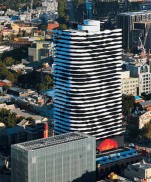The Chieftain of Wurundjeri

Every high-rise building is in some way unique. The skyscraper built in the Australian city of Melbourne, designed by architectural bureau ARM Architecture, attracts special attention resulting of the singular creative solution of its facade. On the tower facade is reproduced a wholescale portrait of William Barak - the last traditional ngurungaeta (elder) of the Wurundjeri-willam clan, who lived on the territory of modern Melbourne for thousands of years before the arrival of Europeans in these places.
William Barak (1824–1903) was an artist, an influential crusader for Aboriginal social justice and an authority on Wurundjeri cultural lore. As an artist, Barak was held in high regard and many of his works are held in Victoria’s cultural institutions. His art showed the complexity and importance of his peoples’ cultural and spiritual life. At Coranderrk, where Indigenous ceremonies were banned, Barak used his paintings to teach and lead his people, passing on Aboriginal history and customs.
According to the architects, the facial image of this legendary person on the facade of building, overlooking the capital city of the state of Victoria, intended to symbolize the heritage of the state and a sign of respect to original Australians.
Barak’s face looking from the 85m height to a modern city connects nowadays Melbourne with its history. “Something like this has been a long time waiting, and I think it’s wonderful. My great grandfather would be so proud.” —Aunty Doreen Garvey-Wandin, Wurundjeri Elder and great granddaughter of William Barak, at the 2010 launch event.
Full content of this issue you can read here
The full version of the article can be read in our printed issue, also you can subscribe to the web-version of the magazine
 Materials provided by ARM Architecture
Materials provided by ARM Architecture


